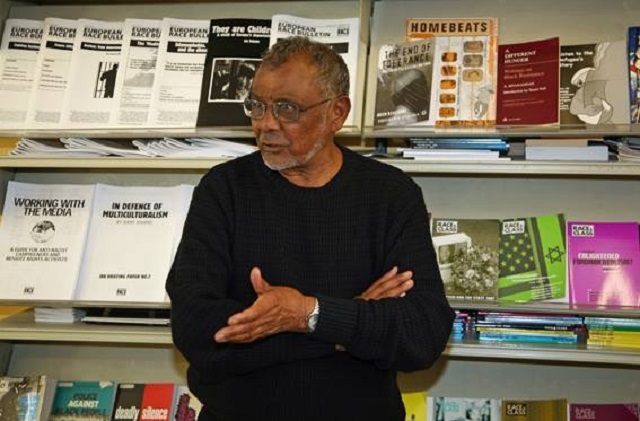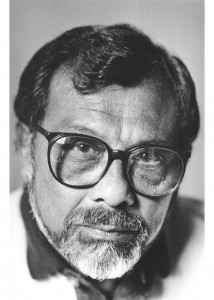The Conscience of the Racially Conscious: Ambalavener Sivanandan, 1923-2018
 Ambalavener Sivanandan, a former bank manager and then librarian who became an award-winning novelist and one of Britain’s foremost political thinkers on race, will be honored this Saturday at London’s Red Lion Square.
Ambalavener Sivanandan, a former bank manager and then librarian who became an award-winning novelist and one of Britain’s foremost political thinkers on race, will be honored this Saturday at London’s Red Lion Square.
Sivanandan died on January 3; he was 94.
To register for a celebration of Sivanandan’s legacy, click here.
Widely known as Siva, Sivanandan was a man who meshed several traditions – art, academics and policy – often using the pages of the journal Race & Class as his megaphone. Saturday’s celebration, titled “The Heart is Where the Battle Is,” reflects those varied parts. The event will feature reflections by artists such as poet Linton Kwesi-Johnson and playwright David Edgar; advocates such as Suresh Grover of The Monitoring Group, Colin Precod and Liz Fekete, chair and director respectively of the Institute of Race Relations; and journalist Gary Younge of The Guardian.
Ambalavener Sivanandan was born in Colombo, Ceylon on December 20, 1923, the son of Tamil postal worker who had emigrated to the country’s capital. Young Siva attended St. Joseph’s College in Colombo, where one of his influences was Sri Lankan essayist J.P. de Fonseka. Fonseka, Sivanandan would later recall, “really stimulated me…De Fonseka gave me a taste for language: English sat on my tongue, I could taste it together with the Tamil I spoke at home.”
 But that love — later manifested in his suite of memorable aphorisms — initially took a back seat to more prosaic concerns, and Sivanandan took a degree in economics at the University of Colombo and started work at the Bank of Ceylon, becoming one of the institution’s first bank managers actually from the island. That period came to an end as anti-Tamil rioting in Ceylon (it was renamed Sri Lanka in 10972) led Sivanandan in 1958 to relocate to Britain – and smack into anti-black rioting in the London suburb of Notting Hill.
But that love — later manifested in his suite of memorable aphorisms — initially took a back seat to more prosaic concerns, and Sivanandan took a degree in economics at the University of Colombo and started work at the Bank of Ceylon, becoming one of the institution’s first bank managers actually from the island. That period came to an end as anti-Tamil rioting in Ceylon (it was renamed Sri Lanka in 10972) led Sivanandan in 1958 to relocate to Britain – and smack into anti-black rioting in the London suburb of Notting Hill.
“The experience and lessons of the ‘double baptism of fire’ of communal conflict in Sri Lanka, where he was born, and racism in the UK remained with him throughout his life,” Grover wrote in an encomium for The Monitoring Group. “The first, where genocide is the eventual outcome, drove him into self-imposed exile and the second led him to define and articulate the power of autonomous black left politics in this country.”
As Sivandanan was to write, “I knew then I was black, I could no longer stand on the sidelines: race was a problem that affected me directly. I had no excuse to go into banking or anything else that I was fitted up to do … I had to find a way of making some sort of contribution to the improvement of society.”
In fact, difficulty in finding a job in banking led him to train as a librarian. He served in several institutions, including the Colonial Office, before he accepted a position as chief librarian at the Institute of Race Relations (IRR) in 1964.
It was at IRR that Sivandanan gained global prominence, especially after a bitter internal dispute, which he in part led, boiled over into a dramatic restructuring of the institute in 1973. Gone were wealthy donors and a focus on race relations; present now was “a think-in-order-to-do-tank for Black and Third World peoples.” Sivandanan was named the ‘new’ IRR’s director, a position he held until 2013.
As Younge wrote in an obituary published by The Guardian, “He went about transforming what was an anodyne academic institution, embedded in the establishment with a government advisory role, into a radical think tank whose mission was to support black communities in their anti-racist struggles both locally and globally.”
The IRR itself, in its page on Sivanandan, describes the changes wrought by Sivanandan in similar terms:
It remains a cutting edge think tank but positions itself between academia and the grassroots. It does not misplace itself in community affairs but provides the ammunition for groups on the ground to conduct their own campaigns against racism. Whereas other NGOs might seek to speak to and influence power-brokers directly, the IRR chooses to ‘speak from’. It takes its cue from the most discriminated against in society and attempts to tackle those issues and subjects where racism is at its most harsh and intractable, and is at pains to present its research findings in an accessible way – ‘the people we are writing for are the people we are fighting for’.
The next year, 1974, he became editor of the institute’s journal Race.
Turning to Younge again:
It was Siva who renamed Race, the IRR’s journal, Race & Class. It became a leading voice for radical race politics, with writers such as John Berger, Angela Davis and Noam Chomsky. His own groundbreaking essays for the journal included The ‘Liberation of the Black Intellectual’ (1974), ‘Race, Class and the State’ (1977) and ‘From Resistance to Rebellion’ (1981), all of which, in different emphases, provided an analytical narrative of the history of black British struggles.
Current IRR Director Fekete, writing to Social Science Space, argued that Sivandanan both disrupted academic endeavor as an activist and embraced it as a fellow traveler:
Many of the tributes and appreciations put up about Siva since his death highlight the fact that in his lifetime he was rather ignored by the intelligentsia (including the left intelligentsia) and that the establishment, including the academic establishment, might prefer to forget him! Siva was an “intervener.” a “disrupter” — his writing paid no respect to academic boundaries. But this does not mean Siva did not value scholarship. On the contrary, he valued scholarship hugely, only he believed, that we should “think in order to do” and that the “purpose of knowledge is to liberate.” That kind of engagement and commitment and passion is very hard for academics to live up to, particularly in the current university climate, I understand if his example appears daunting!
But this kind of example is what made Race & Class, the journal he established, so vitally important throughout the decades, and also today. There are a huge amount of very genuine ‘scholar-activists’ (that was Siva’s preferred term) out there – they want to write scholarly, but they want their knowledge to benefit the most vulnerable in society. Over the years, they find Race & Class, and we find them! Race & Class has always been relevant to the academy in the
sense that it holds up a mirror to it while providing a home for its best scholars.
In 1997, Sivanandan’s novel When Memory Dies , came out. The work, which looks at three geenrations of a family torn by Sri Lanka’s history of colonialism and ethnic strife, won the Sagittarius Prize and was shortlisted for the Commonwealth Writers’ Prize in the category of Best First Book for Europe and South Asia.
Fekete saw When Memory Dies as another manifestation of Sivanandan’s innate ability to disrupt:
You talk about Siva as a novelist, but, for me, this is one of the other boundaries that he transgressed. Everything he wrote was infused with the creative spirit of the imaginative writer, in his politics is poetry and in his novel, When Memory Dies, there is politics and in his political writing there is the emotional depth of the artist. And I think academics in engaging with this kind of legacy should not be frightened. As I said, Siva valued research, he valued scholarship hugely. But he disliked and distrusted the kind of academic language that stripped knowledge of all emotion or that was intellectually obtuse, about scoring points, and proving how clever you were. In another of his famous aphorisms, ‘The people we are writing for are the people we are fighting for.’
Even in the year of his passing, Sivanandan’s messages still resonate, whether in his adopted Britain, Europe, Sri Lanka or the United states. Prescod, writing in the introduction to Sivanandan’s Catching History on the Wing, describes his current relevance:
His coinage of the term xeno-racism acutely exposes the self-serving belief that Europe’s formidable hostility to the impoverished migrant workers on which so much of its basic prosperity depends is but a system of belief and practice aimed at locking down, and locking in, the needy and the desperate. And the war on terror has spawned a new anti-Muslim racism, where minarets mark out the enemy within; a racism, as enacted by governments, that has proved an enemy to freedom of thought, freedom of movement, freedom of conscience, transparency of judicial process and rights to civil liberty.



























































































